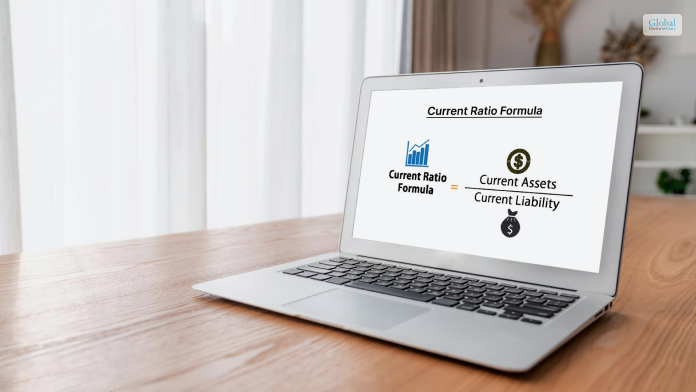What Is The Current Ratio Formula? – Meaning, Interpretation, And More

The current ratio formula is used to calculate the current ratio of a business, This ratio gives an idea of the company’s capacity to repay its short-term loans that are due within a year. This ratio is really helpful for investors as it tells them about the company’s ability to meet its financial obligations. The investors thus evaluate whether the company is financially sound as compared to other competitors and stocks.
‘In this article, you will learn about what the current ratio means and how to calculate it using the current ratio formula. Apart from that, we will also give you tips on how to interpret the situation of a business using the current ratio formula. You will also learn how the current ratio works in general. Finally, we will discuss some of the major pros and cons of using the current ratio formula to calculate the situation of a business.
What Is A Current Ratio?
According to Investopedia,
“The current ratio is a liquidity ratio that measures a company’s ability to pay short-term obligations or those due within one year. It tells investors and analysts how a company can maximize the current assets on its balance sheet to satisfy its current debt and other payables. A current ratio that is in line with the industry average or slightly higher is generally considered acceptable.”
However, if the current ratio of a company is lower than what is expected on average from the industry, this indicates a higher risk of distress or default for the company. On the other hand, if a company has a very high current ratio as compared to its competitors in the same industry, this shows that the company might not be using its assets in an effective manner.
There are various other liquidity ratios that investors use to calculate the situation of a company. Unlike other ratios, the current ratio makes use of all current assets and current liabilities. That is why the word ‘current’ is used here. It is also called the working capital ratio.
Read More: Disaster Recovery Vs Business Continuity – What Are The Differences?
Current Ratio Formula – How To Calculate It?

According to Wall Street Mojo,
“The current ratio equation is a crucial financial metric that assesses a company’s short-term liquidity by comparing its current assets to its current liabilities. A ratio above 1 indicates the company can meet its short-term obligations, while below 1 suggests potential liquidity issues. It aids in evaluating a firm’s financial health and ability to cover immediate debts.”
Here is the formula with which you can calculate the current ratio of a company:
| Current Ratio Formula = Current Assets of the company / Current liabilities of the company |
The current assets of the company are listed in the company’s balance sheet. It consists of the following:
- Cash
- Accounts receivable
- Inventory
- Other current assets (OCA) that the company expects to liquidate or turn into cash within a year
The current liabilities of the company are also listed in the company’s balance sheet. It consists of the following:
- Accounts payable
- Wages
- Taxes payable
- Short-term debts
- Current portion of the long-term debt
Interpreting Using The Current Ratio Formula
Based on the end result of the calculation, it can mean different things for the company. Here is how one can interpret the current ratio based on the results of a company:
- If the Current Assets of the company are greater than the Current Liabilities, then the Current Ratio is greater than 1. This shows a desirable situation for investors and the company.
- If the Current Assets of the company are equal to the Current Liabilities, then the Current Ratio turns out to be exactly 1. This shows that the company’s Current Assets are not enough to pay its short-term obligations.
- If the Current Assets of the company are less than the Current Liabilities, then the Current Ratio is less than 1. This creates a problem for the company since it does not have enough assets to pay for its short-term obligations. Investors mostly do not prefer to invest in such companies.
How Does The Current Ratio Work?
According to TheForage.com,
“The current ratio describes the relationship between a company’s assets and liabilities. So, a higher ratio means the company has more assets than liabilities. For example, a current ratio of 4 means the company could technically pay off its current liabilities four times over. However, what makes a good current ratio depends on the industry.”
In general, if the current ratio of the company stays between 1 and 3, it is an ideal situation for the company to get investments. However, there are certain business models and industries that operate perfectly fine with lower ratios.
What Are The Pros And Cons Of Using Current Ratio?
The following are some of the major pros and cons of calculating a company’s capability using the current ratio formula:
Pros Of Using Current Ratio
Here are the major pros of using the current ratio formula:
- It helps in understanding how cash-rich the company is
- It helps in gauging the short-term financial health, and stability
- It gives an idea of the operating cycle of the company and how efficient it is in selling off its products
- A greater value shows the efficiency of the management
Cons Of Using Current Ratio
Here are a few cons of using the current ratio formula:
- It is not sufficient to analyze the financial situation of the company.
- The inclusion of inventory may lead to overestimation.
- The ratio can be unstable during seasonal sales period.
- A change in the inventory valuation method impacts the ratio.
Read More: Matrix Organizational Structure – What Are Its Pros And Cons?
Wrapping Up
Hope this article was helpful for you in getting a better understanding of how the current ratio formula works for businesses. It basically compares all the current assets of the company to its current liabilities. These assets have high liquidity, that is, either they are already cash, or they can be turned into cash within a year. These can also be liabilities to be paid within a year.
Calculating the current ratio helps investors get a better understanding of whether a company is able to cover its short-term debts with its current assets. Investors also compare this value with other competitors in the industry. Can you share some more applications of the current ratio formula? Share them with us in the comments section below.
Read Also:













